专业英语第一章
- 格式:ppt
- 大小:89.50 KB
- 文档页数:25
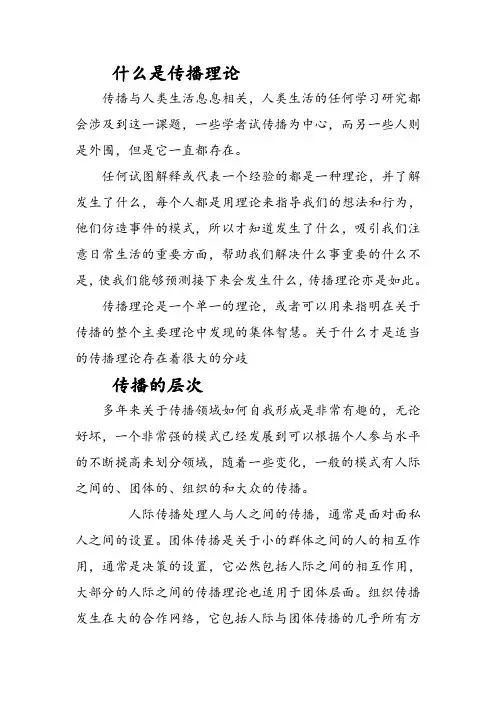
什么是传播理论传播与人类生活息息相关,人类生活的任何学习研究都会涉及到这一课题,一些学者试传播为中心,而另一些人则是外围,但是它一直都存在。
任何试图解释或代表一个经验的都是一种理论,并了解发生了什么,每个人都是用理论来指导我们的想法和行为,他们仿造事件的模式,所以才知道发生了什么,吸引我们注意日常生活的重要方面,帮助我们解决什么事重要的什么不是,使我们能够预测接下来会发生什么,传播理论亦是如此。
传播理论是一个单一的理论,或者可以用来指明在关于传播的整个主要理论中发现的集体智慧。
关于什么才是适当的传播理论存在着很大的分歧传播的层次多年来关于传播领域如何自我形成是非常有趣的,无论好坏,一个非常强的模式已经发展到可以根据个人参与水平的不断提高来划分领域,随着一些变化,一般的模式有人际之间的、团体的、组织的和大众的传播。
人际传播处理人与人之间的传播,通常是面对面私人之间的设置。
团体传播是关于小的群体之间的人的相互作用,通常是决策的设置,它必然包括人际之间的相互作用,大部分的人际之间的传播理论也适用于团体层面。
组织传播发生在大的合作网络,它包括人际与团体传播的几乎所有方面,它包括的课题如结构、组织的功能、人际关系、沟通和组织的过程与组织文化。
最后,通常大众传播通过调解来处理公共传播,在大众传播过程中涉及许多方面的人际的、团体的和组织的传播。
核心传播理论你会遇到许多关于处理传播的特殊方面的理论。
一些理论则解释了传播所独有的层面。
反之,其他的理论则关注了所有传播所共有的常规概念和一般过程。
我们就可以传播的一般处理方法为核心传播理论。
核心理论是特别有意义的,因为它帮助我们在大体上理解了传播。
不论传播在什么时候发生,核心理论都为传播活动的过程提供了见解。
以下的列表列举了核心传播理论的典型要素。
第一,核心理论告诉了我们传播的发展。
第二,核心理论强调了意义的产生与诠释。
第三,核心理论讨论信息结构,亦即信息的元素的组成成分,包括语言、文字与非语文的文本。
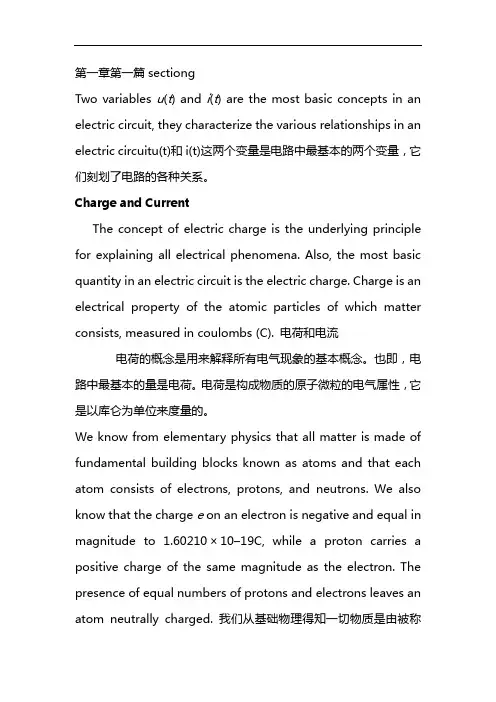
第一章第一篇sectiongTwo variables u(t) and i(t) are the most basic concepts in an electric circuit, they characterize the various relationships in an electric circuitu(t)和i(t)这两个变量是电路中最基本的两个变量,它们刻划了电路的各种关系。
Charge and CurrentThe concept of electric charge is the underlying principle for explaining all electrical phenomena. Also, the most basic quantity in an electric circuit is the electric charge. Charge is an electrical property of the atomic particles of which matter consists, measured in coulombs (C). 电荷和电流电荷的概念是用来解释所有电气现象的基本概念。
也即,电路中最基本的量是电荷。
电荷是构成物质的原子微粒的电气属性,它是以库仑为单位来度量的。
We know from elementary physics that all matter is made of fundamental building blocks known as atoms and that each atom consists of electrons, protons, and neutrons. We also know that the charge e on an electron is negative and equal in magnitude to 1.60210×10 19C, while a proton carries a positive charge of the same magnitude as the electron. The presence of equal numbers of protons and electrons leaves an atom neutrally charged. 我们从基础物理得知一切物质是由被称为原子的基本构造部分组成的,并且每个原子是由电子,质子和中子组成的。
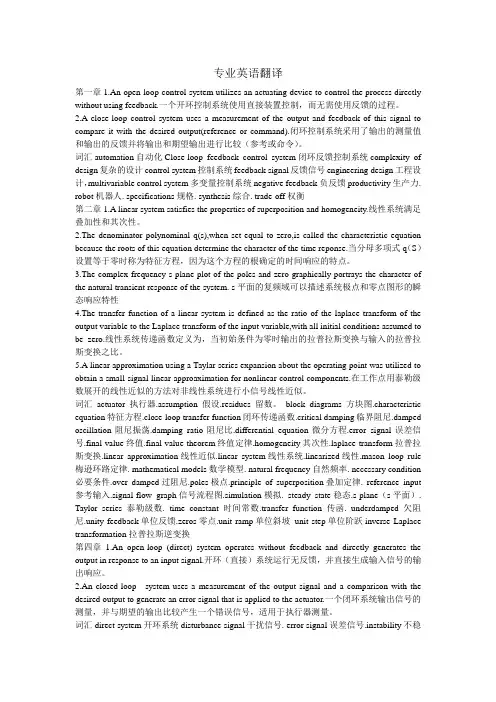
专业英语翻译第一章1.An open-loop control system utilizes an actuating device to control the process directly without using feedback.一个开环控制系统使用直接装置控制,而无需使用反馈的过程。
2.A close-loop control system uses a measurement of the output and feedback of this signal to compare it with the desired output(reference or command).闭环控制系统采用了输出的测量值和输出的反馈并将输出和期望输出进行比较(参考或命令)。
词汇automation自动化Close-loop feedback control system闭环反馈控制系统complexity of design复杂的设计control system控制系统feedback signal反馈信号engineering design工程设计,multivariable control system多变量控制系统negative feedback负反馈productivity生产力. robot机器人. specifications规格. synthesi s综合. trade-off权衡第二章1.A linear system satisfies the properties of superposition and homogeneity.线性系统满足叠加性和其次性。
2.The denominator polynominal q(s),when set equal to zero,is called the characteristic equation because the roots of this equation determine the character of the time reponse.当分母多项式q(S)设置等于零时称为特征方程,因为这个方程的根确定的时间响应的特点。
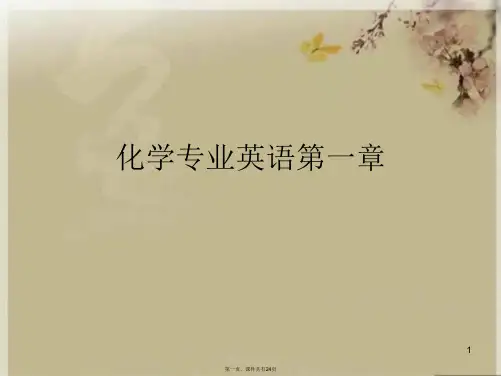
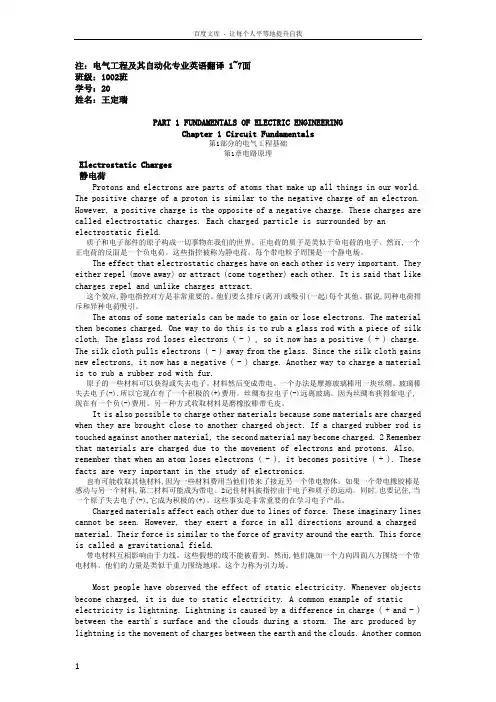
注:电气工程及其自动化专业英语翻译 1~7面班级:1002班学号:20姓名:王定瑞PART 1 FUNDAMENTALS OF ELECTRIC ENGINEERINGChapter 1 Circuit Fundamentals第1部分的电气工程基础第1章电路原理Electrostatic Charges静电荷Protons and electrons are parts of atoms that make up all things in our world. The positive charge of a proton is similar to the negative charge of an electron. However, a positive charge is the opposite of a negative charge. These charges are called electrostatic charges. Each charged particle is surrounded by an electrostatic field.质子和电子部件的原子构成一切事物在我们的世界。
正电荷的质子是类似于负电荷的电子。
然而,一个正电荷的反面是一个负电荷。
这些指控被称为静电荷。
每个带电粒子周围是一个静电场。
The effect that electrostatic charges have on each other is very important. They either repel (move away) or attract (come together) each other. It is said that like charges repel and unlike charges attract.这个效应,静电指控对方是非常重要的。
他们要么排斥(离开)或吸引(一起)每个其他。
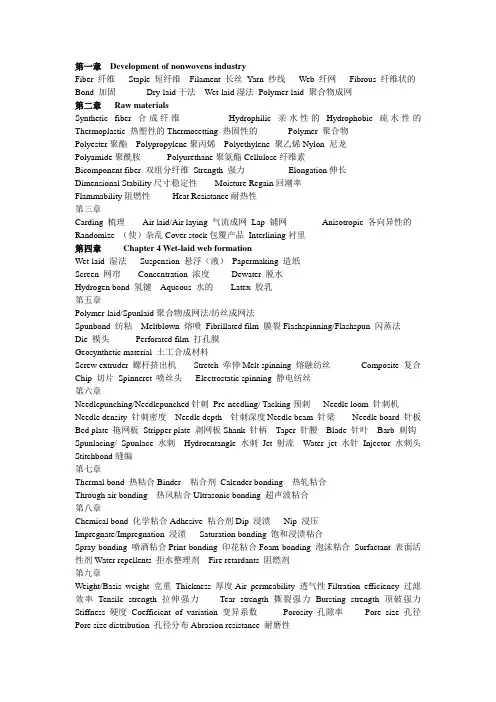
第一章Development of nonwovens industryFiber 纤维Staple 短纤维Filament 长丝Yarn 纱线Web 纤网Fibrous 纤维状的Bond 加固Dry-laid干法Wet-laid湿法Polymer-laid 聚合物成网第二章Raw materialsSynthetic fiber 合成纤维Hydrophilic 亲水性的Hydrophobic 疏水性的Thermoplastic 热塑性的Thermosetting 热固性的Polymer 聚合物Polyester聚酯Polypropylene聚丙烯Polyethylene 聚乙烯Nylon 尼龙Polyamide聚酰胺Polyurethane聚氨酯Cellulose纤维素Bicomponent fiber 双组分纤维Strength 强力Elongation伸长Dimensional Stability尺寸稳定性Moisture Regain回潮率Flammability阻燃性Heat Resistance耐热性第三章Carding 梳理Air laid/Air laying 气流成网Lap 铺网Anisotropic 各向异性的Randomize (使)杂乱Cover stock包覆产品Interlining衬里第四章Chapter 4 Wet-laid web formationWet-laid 湿法Suspension 悬浮(液)Papermaking 造纸Screen 网帘Concentration 浓度Dewater 脱水Hydrogen bond 氢键Aqueous 水的Latex 胶乳第五章Polymer-laid/Spunlaid聚合物成网法/纺丝成网法Spunbond 纺粘Meltblown 熔喷Fibrillated film 膜裂Flashspinning/Flashspun 闪蒸法Die 模头Perforated film 打孔膜Geosynthetic material 土工合成材料Screw extruder 螺杆挤出机Stretch 牵伸Melt spinning 熔融纺丝Composite 复合Chip 切片Spinneret 喷丝头Electrostatic spinning 静电纺丝第六章Needlepunching/Needlepunched针刺Pre-needling/ Tacking预刺Needle loom 针刺机Needle density 针刺密度Needle depth 针刺深度Needle beam 针梁Needle board 针板Bed plate 拖网板Stripper plate 剥网板Shank 针柄Taper 针腰Blade 针叶Barb 刺钩Spunlacing/ Spunlace 水刺Hydroentangle水刺Jet 射流Water jet 水针Injector 水刺头Stitchbond缝编第七章Thermal bond 热粘合Binder 粘合剂Calender bonding 热轧粘合Through air bonding 热风粘合Ultrasonic bonding 超声波粘合第八章Chemical bond 化学粘合Adhesive 粘合剂Dip 浸渍Nip 浸压Impregnate/Impregnation 浸渍Saturation bonding 饱和浸渍粘合Spray bonding 喷洒粘合Print bonding 印花粘合Foam bonding 泡沫粘合Surfactant 表面活性剂Water repellents 拒水整理剂Fire retardants 阻燃剂第九章Weight/Basis weight 克重Thickness 厚度Air permeability 透气性Filtration efficiency 过滤效率Tensile strength 拉伸强力Tear strength 撕裂强力Bursting strength 顶破强力Stiffness 硬度Coefficient of variation 变异系数Porosity 孔隙率Pore size 孔径Pore size distribution 孔径分布Abrasion resistance 耐磨性1. Deifintion of nonwovens?A: A sheet, web or batt of natural and/or man-made fibers or filaments, excluding paper, that have not been converted into yarns, and that are bonded to each other by any of several means.2. classification of nonwovens?A:• Maufacture process: Dry-laid • wet-laid • polymer-laid• Service life:durable(耐久型的)• semi-disposable(半用即弃的)• disposable(用即弃的)3. Basic properties of important fibers such as cotton wool pp petA:Cotton:1.Cotton has low luster(光泽)(unless finishes have been added such as mercerization(丝光处理).2.Cotton has a tenacity of3.0~5.0 grams per denier.(强力为3.0-5.0克每旦尼尔)3.Its elastic recovery is 6~9 percent(弹性回复力)4.Its moisture regain is 8.5 percent.(回潮率)5.It has relatively stable dimensional stability (尺寸稳定性)and does not stretch orshrink.(收缩)6.It burns readily and quickly, with a smell similar to burning paper, it leaves a smallamount of gray ash.7.Cotton is highly resistant to alkalizes strong acid destroy cotton ,cotton is highly8.resistant to most organic solvents.(耐强碱强酸和有机溶剂)9.cotton is damaged by fungi (真菌)such as mildew and by bacteria(细菌)。
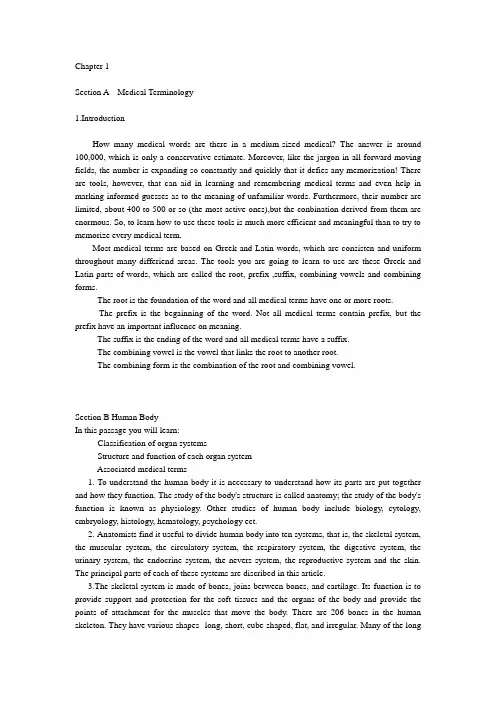
Chapter 1Section A Medical Terminology1.IntroductionHow many medical words are there in a medium-sized medical? The answer is around 100,000, which is only a conservative estimate. Moreover, like the jargon in all forward-moving fields, the number is expanding so constantly and quickly that it defies any memorization! There are tools, however, that can aid in learning and remembering medical terms and even help in marking informed guesses as to the meaning of unfamiliar words. Furthermore, their number are limited, about 400 to 500 or so (the most active ones),but the conbination derived from them are enormous. So, to learn how to use these tools is much more efficient and meaningful than to try to memorize every medical term.Most medical terms are based on Greek and Latin words, which are consisten and uniform throughout many differiend areas. The tools you are going to learn to use are these Greek and Latin parts of words, which are called the root, prefix ,suffix, combining vowels and combining forms.- The root is the foundation of the word and all medical terms have one or more roots.- The prefix is the begainning of the word. Not all medical terms contain prefix, but the prefix have an important influence on meaning.- The suffix is the ending of the word and all medical terms have a suffix.- The combining vowel is the vowel that links the root to another root.- The combining form is the combination of the root and combining vowel.Section B Human BodyIn this passage you will learn:- Classification of organ systems- Structure and function of each organ system- Associated medical terms1. To understand the human body it is necessary to understand how its parts are put together and how they function. The study of the body's structure is called anatomy; the study of the body's function is known as physiology. Other studies of human body include biology, cytology, embryology, histology, hematology, psychology ect.2. Anatomists find it useful to divide human body into ten systems, that is, the skeletal system, the muscular system, the circulatory system, the respiratory system, the digestive system, the urinary system, the endocrine system, the nevers system, the reproductive system and the skin. The principal parts of each of these systems are discribed in this article.3.The skeletal system is made of bones, joins berween bones, and cartilage. Its function is to provide support and protection for the soft tissues and the organs of the body and provide the points of attachment for the muscles that move the body. There are 206 bones in the human skeleton. They have various shapes--long, short, cube-shaped, flat, and irregular. Many of the longbones have an interior space that is filled with bone marrow,where blood cells are made.4. A joint is where bones are joined together. The connection can be so close that no movement is possible, as is the case in the skull.Other kinds of joints permit movement: either back and forth in one plane--as with the hinge joint of the elbow--or movement around a single axis--as with the pivot joint that permits the head to rotate. A wide range of movement is possible when the ballshaped end of one bone fits into a socker at the end of one bone fits into a socket at the end of another bone, as they do in the shoulder and hip joints.5. Cartilage is a more flexible material than bone. It serves as a protective, cushioning layer where bones come together.It also connects the ribs to the breastbone and provides a structural base for the nose and the external ear. An infant's skeleton is made of cartilage that is gradually replaced by bone as the infant grows into an adult.6.The muscular system allows the body to move, and its contractions produce heat, which helps maintain a constant body tempreture. Striated muscles can be constiously controlled.The ends of these muscles are attached to different bones by connective tissue bands so that when the muscle contracts, one bone moves in relation to the other. This makes it possible to move the whole body,as when walking, or to move just one part of the body, as when bending a finger.7.Contractions of the heart and smooth muscles are not under conscious control. Smooth muscles are found in the walls of the organs such as the stomach and the intestines and serve to move the contents of these organs through the body.8.The circulatory system. All parts of the body must have nourishment and oxygen in order to function and grow, and their waste products must be removed before they accumulate and poison the body. The circulatary system distributes needed materials and removes unneeded ones. It is made up of the heart, blood vessels,and blood,which together make up the cardiovascular system.The blood is also part of the body's defense system.It has antibodies and white blood cells that protect the body against foreign invaders.9.The heart is a muscle that is divited into two nearly identical halves: one half receives boold from the lungs and sends it to the rest of the body, the other half sends blood that has traveled through the body back to the lungs.When the heart muscles contracts,the blood is forced out into arteries and enters small capillaries. Blood returns to the heart through veins.10.Also functioning in circulation is the lymphtic system.Some of the fluid that surrounds cells does not reenter the blood vessels directly.This fluid, called lymph, returns to the heart by way of another system of channels--the lymph vessels.Lymph nodes along these vessels filter the fluid before it reenters the blood.The spleen is a large lymphatic organ that filters the blood.11.The respiratory system takes in oxygen from the air and expels carbon dioxide and water vapor.Air enters the nose and mouth and travels through the larynx,and trachea.The trachea divedes to enter each of the teo lungs and then divides more than 20 times to form a very large number of small air spaces. Oxygen from the air enter the blood through capillaries in the walls of these air spaces,and the blood releases carbon dioxide into the air spaces to be exheled.12.The digestive system consists of a tube extending from the mouth to the anus.In it, food and fluids are taking in,moved through the body,and broken down into small molecules that are obsorbed into the circulatory system.This breakdown, known as digestion,is both a mechanical and a chemical process.13.Food enters through the mouth, where chewing and saliva start to break it up and make it easier to swallow.Next the food travels down through the esophagus to the stomach.Contraction ofthe stomach's muscular wall continue to break down the food mechanically,and chemical digestion continues when acid and enzymes are secreted into the stomach cavity.14.The liquified food gradually passed into the small intestine.In the first part of the small intestine,called the duodenum,enzymes from the pancreas are added. These enzymes complete the chemical breakdown of the food.The digestion of fat is added by bile,which is made in the liver and stored in the gall bladder.The small intestine of an adult is about 21 feet(6.4 meters) long.Most of its length is devoted to avsorbing the nutrients released during these digestive activities.15.The liquid remainder of the food enters the large intestine,or colon,which is about 12 feet(3.7 meter) long.It is more than twice as wide as the small intestine.In the large intestine most of the fluid is absorbed, and the relatively dry residues are expelled.16.The urinary system maintains normal levels of water and of certain small molecules such as sodium and potassium in the body. It does this by passing blood through the kidneys, two efficient filtering organs that get rid of any excess of various molecules and conserve those molecules that are in short supply.17.The fluid that leaves the kidneys,known as urine,travles through a tube called the ureter to the bladder.The bladder holds the urine until it is voided from the body through another tube, the urethra.18.The endocrine system. The two system that control body activities are the endocrine system and the nervous system.The former exerts its control by means of chemical messengers called hormones. Hormones are produced by a variety of endocrine glands, which release the hormones directly into the blood stream.19.A major gland is the pituitary, which is located under the brain in the moddle of the head.It produces at least eight hormones, which affect growth, kidney function, and development of the sex organs.Because some of the pituitary's hormones stimulate other glands to produce their own hormones,the pituitary is called the master gland.20.Another gland, the thyroid is located between the collar bones.Its hormone controls the rate of the body's metabolism.The sex organs(ovaries and tests)make the sex cells and also make hormones that control certain characteristics of the males and females. Located on the top of each kidney is the adrenal gland,which produces cortisone and adrenaline.The pancreas produce not only digestive enzymes but also insulin and glucagon, which control the body's use of the sugar and starches.21.The nervous system--the brain, the spinal cord, and the nerves--also controls body activities.The lower parts of the brain control basic functions such as breathing and heart rate as well as body temperature ,hunger,and thirst.Above these regions are the centers for sight, sound, touch, smell, and taste, and the regoins that direct voluntory muscular activities of the arms and legs.Performed here are the higher functions of integrating and processing information.22.The brain receives and sends information by means of nerves, many of which lie partly in the spinal cord.The spinal cord is protected by the spinal column.Nerves enter aand leave the spinal cord at each level of the body,traveling to and from the arms, legs, and trunk.These nerves bring information from the various sence organs.The information is processed by the brain, and the messages are carried back to muscles and glands throughout the body.23.The reproductive system is constructed differently for males and females. The male reproductive system is responsible for producing , transporting and maintaining viable sperm(the male sex cell).It also produces the male sex hormone, testosterone, which regulates thedevelopment of a bread, pubic hair, a deep voice and other bodily characteristics of the adult male.24.The female productive system is responsible for producing and transporting ova(the female sex cells) eliminating ova from the body when they are not fertilized by sperm, and nourishing a newborn child.The female reproductive system also produces the female sex hormones, estrogen and progesterone, which regulate the development of breasts and other bodily characteristics of the mature female.25.The skin is complete layer that protects the inner structures of the body, and it is the largest of the body's organs.It keeps out finger substances and provents excessive water evaporation.The nerves in the skin provide tactile information.The skon also helps keep the body's temperature close to 98.6℉(about 37℃): heat is conserved by reducing blood flow through the skin or is expended by increasing blood flow and by evaporation of sweat from the skin.Hair and nails are accessory structures of the skin.第一章医学术语A部分1.Introduction有多少医学词是在一个中等大小的体检吗?答案是大约10万,这只是保守的估计。
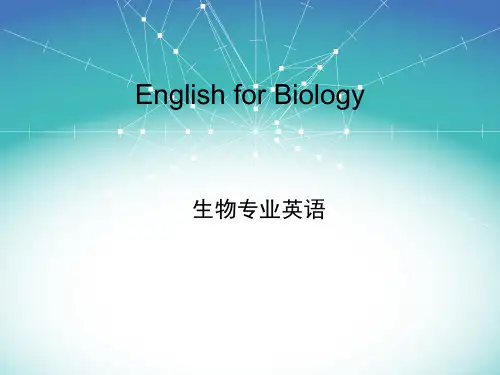
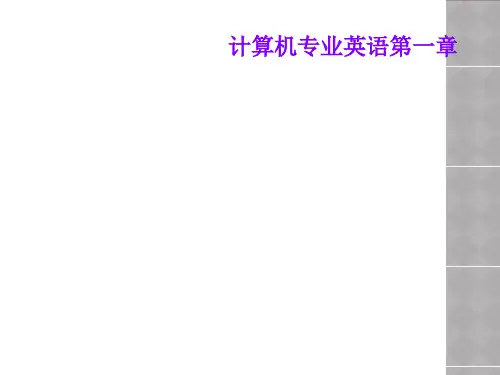
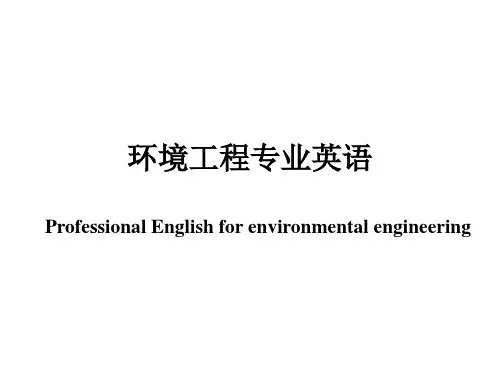
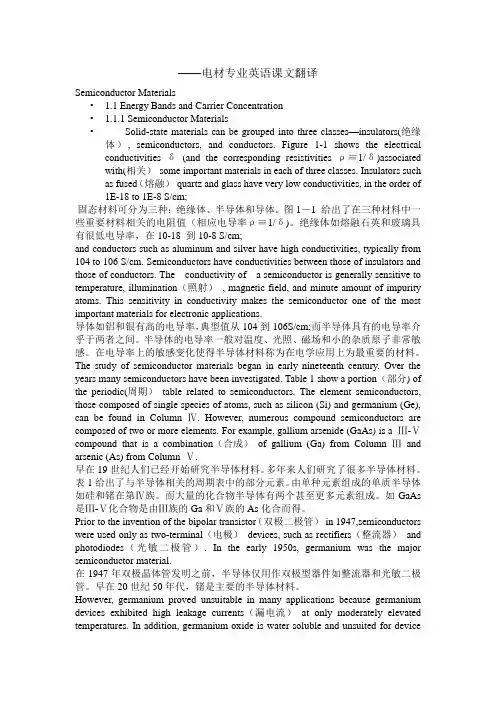
——电材专业英语课文翻译Semiconductor Materials• 1.1 Energy Bands and Carrier Concentration• 1.1.1 Semiconductor Materials•Solid-state materials can be grouped into three classes—insulators(绝缘体), semiconductors, and conductors. Figure 1-1 shows the electrical conductivities δ(and the corresponding resistivities ρ≡1/δ)associated with(相关)some important materials in each of three classes. Insulators such as fused(熔融)quartz and glass have very low conductivities, in the order of 1E-18 to 1E-8 S/cm;固态材料可分为三种:绝缘体、半导体和导体。
图1-1 给出了在三种材料中一些重要材料相关的电阻值(相应电导率ρ≡1/δ)。
绝缘体如熔融石英和玻璃具有很低电导率,在10-18 到10-8 S/cm;and conductors such as aluminum and silver have high conductivities, typically from 104 to 106 S/cm. Semiconductors have conductivities between those of insulators and those of conductors. The conductivity of a semiconductor is generally sensitive to temperature, illumination(照射), magnetic field, and minute amount of impurity atoms. This sensitivity in conductivity makes the semiconductor one of the most important materials for electronic applications.导体如铝和银有高的电导率,典型值从104到106S/cm;而半导体具有的电导率介乎于两者之间。
The Special English of Land ManagementPart 1The Introduction of Land resources Management in ChinaPh.D Bao LiangPrivate e-mail: hearsay0471@Course Resource in Public e-mail box:Baoliang_kejian@Code: 010018Contents0. General Introduction (3)1.The general Introduction of Land resources Management in China (中国土地资源管理概况) (4)1.1 Theintroduction of The Ministry of Land and Resources P.R.C (14)1.1.1 Mission (14)1.1.2 Organization (18)1.1.3 History (20)2.China’s Land Market: Current Situation, Problem and Development Trends(中国土地市场现状、问题与发展趋势) (21)0. General Introduction0.1 Introduce Myself (5min)0.2 Curse introduction(5min)The special English of land management课程目的与要求:《土地管理專業英語》课程重點介紹國內外土地资源管理的基本特点和发展规律。
課程根据党和国家的方针政策、人民群众和社会发展对土地管理的需求,运用现代管理科学的理论、方法、技术,结合中国实际,討論中国土地资源管理的理论和方法、講解适应中国国情的土地政策;通过本课程的学习,使学生了解國內外土地资源的现状和发展趋势,掌握土地管理的基本规律与基本理念,掌握土地事业管理的基本方法和基本技能,了解我国土地管理事业运行和发展机制,為进一步加强我国国土资源的管理和有效合理利用奠定基礎。
第一单元(HB纯手工出版)(1-1)Many of the products and services in modern society are based upon the work of electrical engineers and computer scientists. The tremendous reduction over the last decade in the cost of digital electronic devices has led to an explosive growth in the use of computers and computation. At the same time, our increased understanding of computer science has made possible the development of new software systems of increased power, sophistication, and flexibility.现代社会的许多产品和服务都是以电气工程师和计算机科学家的工作为基础的。
在过去的十年里,数字电子设备成本的大幅降低导致了计算机和计算的爆炸性增长。
与此同时,我们对计算机科学的理解不断加深,使得开发更强大、更复杂、更灵活的新软件系统成为可能。
(1-2) In November 1971,Intel introduced the world's first commercial microprocessor, the4004,invented by three Intel engineers. Primitive by today' s standards, it contained a mere 2, 300 transistors and performed about 60, 000 calculations in a second. Today, the microprocessor is the most complex mass- produced product ever, with millions of transistors performing hundreds of millions of calculations each second.1971年11月,英特尔公司推出了世界上第一台商用微处理器,代号4004,由三位因特尔工程师发明。